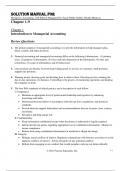Exam (elaborations)
Solution Manual For Horngren's Accounting, 13th Edition Managerial by Tracie Miller-Nobles, Brenda Mattison
- Course
- Institution
Solution Manual For Horngren's Accounting, 13th Edition Managerial by Tracie Miller-Nobles, Brenda Mattison
[Show more]



